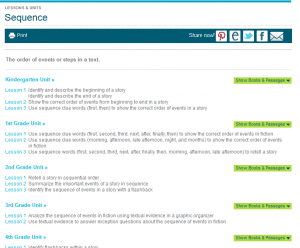Common Core Reading Lessons: Sequence
 The order of events or steps in a text.
The order of events or steps in a text.
Sequence Lessons - Covers kindergarten through sixth grade. Examples: Show the correct order of events from beginning to end in a story. Use sequence clue words (morning, afternoon, late afternoon, night, and months) to show the correct order of events in fiction. Summarize the important events of a story in sequence. Use textual evidence to answer exception questions about the sequence of events in fiction. Identify the chronological order of events in a story with flashbacks.
Key Ideas and Details
CCSS.ELA-Literacy.RL.K.3 With prompting and support, identify characters, settings, and major events in a story.
Key Ideas and Details
CCSS.ELA-Literacy.RL.1.2 Retell stories, including key details, and demonstrate understanding of their central message or lesson.
Craft and Structure
CCSS.ELA-Literacy.RL.2.5 Describe the overall structure of a story, including describing how the beginning introduces the story and the ending concludes the action.
Key Ideas and Details
CCSS.ELA-Literacy.RL.3.1 Ask and answer questions to demonstrate understanding of a text, referring explicitly to the text as the basis for the answers.
Comprehension and Collaboration
CCSS.ELA-Literacy.SL.3.2 Determine the main ideas and supporting details of a text read aloud or information presented in diverse media and formats, including visually, quantitatively, and orally.
Key Ideas and Details
CCSS.ELA-Literacy.RL.4.1 Refer to details and examples in a text when explaining what the text says explicitly and when drawing inferences from the text.
CCSS.ELA-Literacy.RL.4.2 Determine a theme of a story, drama, or poem from details in the text; summarize the text.